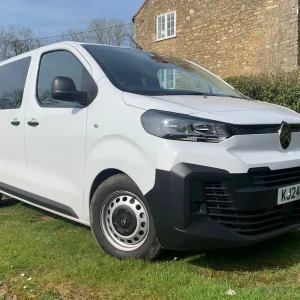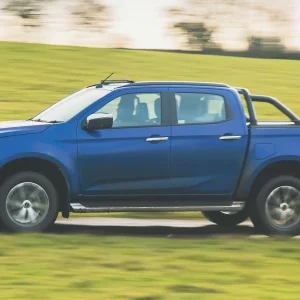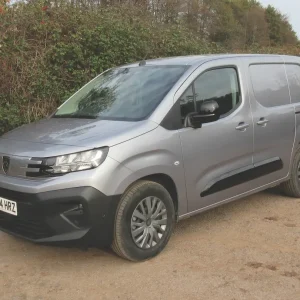
With 130hp on tap, performance was never an issue for the Combo Cargo, the handling seemed to get better and better as the weeks went on, and I was grateful for all the onboard safety kit, much of which was admittedly optional.
I was especially grateful for speed sign recognition. It shows you the speed you should be doing plus the speed you are doing in reality, with both shown on the vehicle’s optional head-up display. As well as enhancing highway safety it is a potential licence-saver.
The Combo Cargo gets top marks for its low-speed manoeuvrability, which was enhanced by the optional Parking Pack. Ultrasonic sensors sound the alarm if you are about to smack the van’s sides against a wall or another vehicle.
Another option worth mentioning is the Winter Pack, which includes heated seats and a heated steering wheel – just what you need first thing in the morning in chilly weather.
I liked the satellite navigation system too. A standard feature on LE Nav models, it provides clear and accurate visual and verbal instructions.
Fuel consumption remained at around 60.0mpg throughout my time with the vehicle, which was beneath the official combined figure, but not calamitously so. A readily accessible load area, a beefy full-height bulkhead, and FlexCargo, which allows extra-long items such as pipes to be transported in the back if you fold the cab’s outboard passenger seat down, made the van a perfectly competent load-carrier.
Drawbacks? Wind and road noise were a touch too high, and I cannot understand why manufacturers insist on stuffing three seats into a cab that only has room for two. A severe lack of leg and shoulder room means the extra seat isn’t fit for anybody other than your teddy bear. As far as I was concerned its only advantage was the ability to flip its back down and turn it into a desk.
The Combo Cargo is for the most part well-built, but regular rattling and creaking from the bulkhead almost drove me mad. The culprit turned out to be the FlexCargo hatch.
Bizarrely, you can shove over-length loads into what looks like a gigantic sock in a bid to stop them from rolling across the cab and ending up in the driver’s lap. It’s a rather awkward arrangement, and not one I favour particularly.
Overall, though, this light commercial is a useful workhorse with more plus points than drawbacks.
Remember also that it is sold by Citroen as the Berlingo, by Peugeot as the Partner and by Toyota as the Proace City. All four jointly scooped What Van?’s Light Van of the Year Award for 2020.
End-of-term report
Safety =4/5
A mountain of safety kit.
Options list = 4/5
Plenty of tempting boxes to tick.
Driving = 4/5
No lack of performance and spot-on handling, but in-cab noise is a bit too high.
Load bay =4/5
Practical and accessible, but the FlexCargo feature is awkward to use.
Cabin = 3/5
Why shoehorn in three seats? And some of the switchgear is too small.
Build quality = 3/5
Okay, bar the rattling FlexCargo hatch.
Overall score: 73%
Cargo LE Nav L1H1 2000 1.5 130hp Turbo D Start/Stop
Mileage 4,237
Official combined consumption 64.2mpg
Our average consumption 60mpg (estimated)
Price (ex VAT) £20,105
Warranty 3yrs/60,000mls
Service intervals 2yrs/25,000mls
Load length 1,817mm
Load width (min/max) 1,229/1,550mm
Load bay height 1,236mm
Gross payload 658kg
Load volume 3.3m3
Engine size/power 1,499cc/130hp
Gearbox 6spd manual
CO2 117g/km
Options
Parking Pack £700
Safety Pack £570
FlexCargo Pack £510
Head-up Display £300
Sight and Light Pack £225
Electronic climate control £200
Winter Pack £150
Wireless charger £80
(See below for previous reports)

The AdBlue filler point is under a flap next to the diesel filler point
Service intervals have been stretched so far in recent years it can become difficult to recall when your van is due its next visit to the workshop.
With the Combo, however, all you need to do is interrogate the onboard computer, and it will tell you.
In addition it will tell you when you next need to replenish the AdBlue reservoir – advice that should be heeded. Keep ignoring it, and let the AdBlue level fall, and a series of warnings will be triggered. Eventually your van will refuse to start. You’ll find the AdBlue filler point under a flap next to the diesel filler point.
The onboard computer will also tell you how far you can travel before you need to refuel.
Only an idiot will text or email using a hand-held smartphone while driving, but staff still need to stay in contact on the road and the Combo’s Bluetooth connectivity allows them to do so without endangering themselves or other road users.
Pair up your phone and you can send short, predetermined messages to key recipients (“I’ll be late, I’m just arriving, Not available etc.”) simply by pressing the touchscreen once.
Not being a big fan of the nanny state, I was initially hostile to the Combo’s Driver Alert system. If it reckons your driving is becoming wayward because you are tired, or if you have been driving for more than two hours at above 40mph without taking a break, it displays a cup of coffee symbol on the dash as well as setting off an acoustic warning. Keep driving and the alert is sounded every hour. My hostility has abated, however. Driving while tired can be a recipe for disaster – and pulling over for 10 minutes won’t hurt.
Report Card: Technology = 4/5
Stress on safety is worthy of praise
Cargo LE Nav L1H1 2000 1.5 130hp Turbo D Start/Stop
Mileage 3,568
Official combined consumption 64.2mpg
Our average consumption 60mpg (estimated)
Price (ex VAT) £20,105
Warranty 3yrs/60,000mls
Service intervals 2yrs/25,000mls
Load length 1,817mm
Load width (min/max) 1,229/1,550mm
Load bay height 1,236mm
Gross payload 658kg
Load volume 3.3m3
Engine size/power 1,499cc/130hp
Gearbox 6spd manual
CO2 117g/km
Options
Parking Pack £700
Safety Pack £570
FlexCargo Pack £510
Head-up Display £300
Sight and Light Pack £225
Electronic climate control £200
Winter Pack £150
Wireless charger £80
(See below for previous reports)

4th Report
I’ve become a major fan of the Vauxhall Combo Cargo’s head-up display.
Being able to see the speed you are doing and the speed you should be doing at a glance benefits safety, no question about it. It helps keep you legal too.
Elsewhere, active safety brake (ASB), which can be switched on and off, is another one of the Vauxhall Combo Cargo’s impressive safety features. Functioning at speeds from 3mph to 52mph, it applies the brakes if it feels you are getting dangerously close to the vehicle in front. It also reacts if a pedestrian wanders into your path, or if an errant obstacle suddenly appears on the road ahead. You can use the touch-screen to adjust the distance at which it intervenes. There are three settings: Close, Normal, and Distant. It makes its presence felt occasionally but is not excessively sensitive, as some of these systems are.
Another worthwhile safety feature that can be switched on and off is high beam assist. Use it and your headlights will stay on main beam at night when you are travelling at more than 15mph. They dip automatically when an oncoming vehicle approaches, if you come up behind a vehicle, in fog and in snow, if you drive into a town centre, or if your speed drops below 9mph.
Report Card: Safety = 4/5
Wealth of kit protects occupants.
Cargo LE Nav L1H1 2000 1.5 130hp Turbo D Start/Stop
Mileage 2,668
Official combined consumption 64.2mpg
Our average consumption 60mpg (estimated)
Price (ex VAT) £20,105
Warranty 3yrs/60,000mls
Service intervals 2yrs/25,000mls
Load length 1,817mm
Load width (min/max) 1,229/1,550mm
Load bay height 1,236mm
Gross payload 658kg
Load volume 3.3m3
Engine size/power 1,499cc/130hp
Gearbox 6spd manual
CO2 117g/km
Options
Parking Pack £700
Safety Pack £570
FlexCargo Pack £510
Head-up Display £300
Sight and Light Pack £225
Electronic climate control £200
Winter Pack £150
Wireless charger £80
(See below for previous reports)

3rd Report
Chilly early morning starts always make me hope that my van’s cab will warm up quickly and the windows will demist as if by magic so I can be on my way pronto.
Fortunately, the Combo Cargo’s heater responds rapidly and the cab is soon reasonably comfortable, although the windows take a bit of time to clear.
The level of comfort is enhanced further by the presence of heated seats and a heated steering wheel, both of which feature in the optional Winter Pack fitted to our demonstrator. At this time of year you realise it is money well spent.
The heated exterior mirrors and front fog lights are welcome too. Both of them are standard with LE Nav specification.

Full-height bulkhead helps keep in the heat
Cabs are a lot snugger when a solid full-height bulkhead is fitted because the heater is not fighting to raise the temperature of the whole interior of the vehicle. It means they are cooler in summer too because the air-conditioning system – What Van?’s Combo Cargo is equipped with optional electronic climate control – is not trying to bring down the temperature of the load area as well as that of the driver and passenger.
Happily, Combo Cargo has a beefy steel bulkhead that extends from the floor to the roof. Its prime function is, of course, to protect the occupants of the cab from being hit by loose cargo and I was grateful for its presence during a recent run down the M5. A heavy wooden packing case full of all sorts of junk that had not been properly lashed down decided to break loose from its moorings and struck the bulkhead with an almighty wallop.
It then shot backwards and thudded into the rear doors, prompting me to wonder whether it would burst through them and end up on the carriageway. Fortunately, the doors and the locks that secure them are beefier than I expected them to be. They held, and I was able to get to Strensham Services and re-secure my load after a fashion. (Memo to self: get rid of those frayed, old lashing straps and buy some new ones sharp-ish.)
Leaving this bit of excitement to one side, I remain more than happy with the van’s handling – it seems to get better and better – and fuel consumption, which keeps steady at around 60mpg. The hatch in the bulkhead that forms part of the FlexCargo package – it allows the load bed to be extended so that extra-long items can be transported – still rattles, however, and I cannot help but think that in-cab noise levels overall could stand to be better controlled.
I’m getting used to the satnav, a standard feature on LE Nav models as part of the Multimedia Navi Pro package. The on-screen directions it provides are clear, so are the verbal instructions, and – unlike some systems I have encountered – it can be easily switched off once you are close to your destination and no longer require its assistance.
Report Card: Fuel economy = 4/5
Won’t break the bank.
Cargo LE Nav L1H1 2000 1.5 130hp Turbo D Start/Stop
Mileage 1,978
Official combined consumption 64.2mpg
Our average consumption 60mpg (estimated)
Price (ex VAT) £20,105
Warranty 3yrs/60,000mls
Service intervals 2yrs/25,000mls
Load length 1,817mm
Load width (min/max) 1,229/1,550mm
Load bay height 1,236mm
Gross payload 658kg
Load volume 3.3m3
Engine size/power 1,499cc/130hp
Gearbox 6spd manual
CO2 117g/km
Options
Parking Pack £700
Safety Pack £570
FlexCargo Pack £510
Head-up Display £300
Sight and Light Pack £225
Electronic climate control £200
Winter Pack £150
Wireless charger £80
(See below for previous reports)

2nd Report
A polite but firm twitch on the steering wheel that nudges you back into your lane on the motorway can be a bit disconcerting if you’re not expecting it.
That is what you receive when driving a Vauxhall Combo Cargo and idly wander over the white dividing lines, and that’s because it is equipped with an optional Safety Pack with lane departure warning.
Whether you think it’s worth the extra £570 depends on the type of work you are on. S
pend a lot of time hacking up and down the M5 then the answer has to be ‘yes’, but if your day consists of trundling around city centres in stop-start traffic, then it probably isn’t.
That said, the package includes speed sign recognition, with the sign advising you of the prevailing limit shown on an optional head-up display together with your actual speed.
If a timely warning stops you from getting three points, a fine, and the subsequent hike in your insurance premium, then suddenly the price seems very much worth it.
The head-up display also shows two converging green lines – if you drift out of lane then the appropriate one changes colour as your steering wheel starts to twitch.

What on the face of it seem minor irritations can begin to loom large if you spend a lot of time in a van. Like all LCVs, the Combo Cargo has one or two.
The switches for the heating and ventilation system’s booster fan are too small, and hidden by the steering wheel if, like me, you sit close to it.
Nor is it immediately obvious what the two little paddles on the fascia are. At first I thought they were some sort of chrome ornamentation, but it turns out they control the heater.
FlexCargo option gives you a hatch in the bulkhead to extend the load bed
Specify the FlexCargo option and you get a hatch in the bulkhead behind the passenger seat that opens to allow you to extend the load bed if you fold the seat down.
But no matter how carefully I secure the hatch, it insists on rattling – a real annoyance on a long journey. At first it was only intermittent; now it is almost continuous, and it’s a shame because there is nothing else wrong with the vehicle’s quality.
On the plus side the van’s handling gets better and better. It sweeps through the tightest of bends without any tendency to break away. And yet again I must praise its low-speed manoeuvrability.
It can wriggle into surprisingly tight spaces – the optional Parking Pack, with ultrasonic side sensors, front and rear parking-distance sensors and rear-view camera, clearly helps.
Report Card: Handling = 5/5
Exemplary.
Cargo LE Nav L1H1 2000 1.5 130hp Turbo D Start/Stop
Mileage 1,258
Official combined consumption 64.2mpg
Our average consumption 60mpg
Price (ex VAT) £20,105
Warranty 3yrs/60,000mls
Service intervals 2yrs/25,000mls
Load length 1,817mm
Load width (min/max) 1,229/1,550mm
Load bay height 1,236mm
Gross payload 658kg
Load volume 3.3m3
Engine size/power 1,499cc/130hp
Gearbox 6spd manual
CO2 117g/km
Options
Parking Pack £700
Safety Pack £570
FlexCargo Pack £510
Head-up Display £300
Sight and Light Pack £225
Electronic climate control £200
Winter Pack £150
Wireless charger £80
(See below for previous reports)

1st Report
Vauxhall’s new Combo Cargo has joined the What Van? long-term test fleet and I celebrated the fact by giving our 2019 LCV of the Year an extremely long run barely 48 hours after it had arrived.
Ross-on-Wye in Herefordshire and central Glasgow are 362 miles apart, and with various side trips I clocked up just over 800 miles.
Happily, the newcomer came with the 130hp version of the 1.5-litre BlueHDi Euro6.2 diesel – the most powerful engine available in the Combo, with 300Nm of torque on tap. As a consequence, long-distance performance was not an issue given that it’s the short-wheelbase model and had barely 50kg in its 3.3m3 cargo area.
A six-speed manual gearbox is standard with this model. Ideal for motorway work, it’s equally useful when it comes to dodging around busy city streets. An eight-speed automatic box is listed as an option and is likely to prove even more useful.
Given the length of the trek – much of it on the M6 – I was grateful for the presence of an optional Safety Pack with lane departure warning. It includes speed sign recognition too. In our case the speed limit on whichever highway the Combo happens to be on is shown on an optional head-up display that also gives you the speed you are actually doing. Its presence regularly prompted me to slow down, and it is without doubt a licence-saver.
The satellite navigation system that forms part of the top-of-the-range LE specification – Edition and Sportive are the other trim levels – gets top marks for its audible and visual
clarity. The map and the direction you are heading in is shown on an 8in colour touchscreen.
The Combo also gets top marks for its low-speed manoeuvrability, which was put to the test in an underground car park in Glasgow with unusually narrow ramps and tight turns. Happily, our test van is equipped with an optional Parking Pack with ultrasonic sensors that warns drivers if they are about to wallop the van’s sides.
Gripes? The lack of adjustment in the passenger seat prompted periodic complaints from its usual occupant, and wind and road noise is a little too high.
Turning to fuel economy, the official combined figure is 64.2mpg. I averaged closer to 60mpg on my England-to-Scotland hike.
The Combo shared What Van?’s much-prized LCV of the Year accolade with Peugeot’s Partner and Citroen’s Berlingo. All three share the same platform, are virtually identical bar some cosmetic differences, and Vauxhall, Peugeot and Citroen are all owned by PSA.
Like its stablemates, the Combo is marketed with two different wheelbases delivering two different overall lengths: L1 and L2. There is one roof height giving a load cube of either 3.3m3 or 3.8m3, while gross payload capacities run from 654kg to 987kg.
The Combo is also available as a crew van and with 75hp and 100hp versions of the 1.5-litre, both of which come with five-speed manual gearboxes. Toyota has started marketing its own version of the Combo/Partner/Berlingo under the Proace City banner.
Our test van is equipped with FlexCargo – yet another option – which means that the bulkhead features an opening panel behind the passenger seat. It allows a load-through facility to be created once you have folded the seat down so that extra items can be transported, and they can be pushed into what is in effect a large sack to stop them rolling around the cab. FlexCargo comes with a middle seating position, but I remain unconvinced that three abreast makes any sense whatsoever in a cab of this size. The centre seat is unviable for anything but the shortest of trips because it offers no legroom whatsoever. Its only plus point is that its back can be folded down and turned into a desk the driver can use to fill in paperwork, although fewer and fewer people resort to paper forms these days.
Report Card: Build quality = 4/5
Fine, bar the occasional squeak.
Cargo LE Nav L1H1 2000 1.5 130hp Turbo D Start/Stop
Mileage 811
Official combined consumption 64.2mpg
Our average consumption 60mpg
Price (ex VAT) £20,105
Warranty 3yrs/60,000mls
Service intervals 2yrs/25,000mls
Load length 1,817mm
Load width (min/max) 1,229/1,550mm
Load bay height 1,236mm
Gross payload 658kg
Load volume 3.3m3
Engine size/power 1,499cc/130hp
Gearbox 6spd manual
CO2 117g/km
Options
Parking Pack £700
Safety Pack £570
FlexCargo Pack £510
Head-up Display £300
Sight and Light Pack £225
Electronic climate control £200
Winter Pack £150
Wireless charger £80





